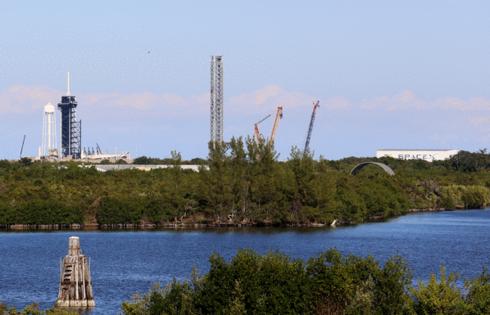1st Starship launch on Space Coast could come mid-2026, Space Force official says
Published in News & Features
ORLANDO, Fla. — While SpaceX continues to test its Starship and Super Heavy rocket in Texas, Space Force officials in Florida are preparing for a first launch as early as mid-2026.
SpaceX is awaiting the completion of a pair of environmental impact statements for its plans to launch from both Kennedy Space Center’s Launch Complex 39-A and Cape Canaveral Space Force Station’s Space Launch Complex 37.
“KSC is leading the way with (LC 39-A) and the partnership with SpaceX there to do the development work to be able to support Starship,” said Space Launch Delta 45 commander Col. Brian Chatman during a media discussion about the 100th launch of the year on the Space Coast. “Early- to mid-next year is when we anticipate Starship coming out here to be able to launch, and we’ll have the range rated to support at that time.”
Construction at the KSC site is moving ahead while SpaceX also builds out a Starship manufacturing facility nearby called the Gigabay to pump out the rocket stages for the 403-foot-tall behemoth.
The majority of those would be at a second launch site at the former launch complex that supported United Launch Alliance’s now-retired Delta IV Heavy rockets, the last of which launched in 2024.
Starship produces nearly 17 million pounds of thrust on liftoff with its first-stage booster designed to come back to the launch site to be caught by a pair of swiveling arms called “chopsticks” on the launch tower, allowing for rapid reuse. The upper stage also has the capacity to return for a landing at the launch site.
The pair of environmental impact statements said the two launch sites seek to support up to 120 launches combined per year, each that could see both return booster landings to the launch site as well as returns of the upper stage after orbiting the Earth at least once.
Because Starship is powered by a methane-based propellant with liquid oxygen (LOX), and the size and power is so potent, the safety zones are based on blast damage assessments (BDAs) that are much bigger that those for rockets like SpaceX’s Falcon 9.
“When we talk about public safety, we talk about risk. Today, we treat the LOX-methane analysis as a 100% TNT equivalency from a blast radius perspective,” Chatman said.
Chatman discussed the difficulties juggling the needs of multiple launch providers from multiple launch sites, including ULA’s remaining facility at Space Launch Complex 41, which falls within the range safety keep-out sphere for Starship’s planned KSC launches.
“There are times where there will be neighboring operations that when they have a fueled vehicle, will have a BDA, or keep-out zone, from one launch complex that impedes another,” he said.
Blue Origin’s New Glenn and ULA’s new Vulcan rockets also use the LOX-methane system, and Chatman expects the safety parameters to be eased over time as more launches are knocked out.
“At that point in the future, I do anticipate the blast damage assessments to shrink down based on the testing that will have been accomplished,” he said. “We don’t know how much that is going to shrink.”
For now, the different companies, including SpaceX, Blue Origin, ULA as well as newcomers like Vaya Space, RocketLab, Firefly Aerospace and Relativity Space, all meet on a weekly basis with the Space Force to work out scheduling.
“They understand neighboring operations. They understand that we will allow the maximum efficiency possible to facilitate their operations, but there will be times that we’re not going to let them go to their launch complex because it’s neighboring a hazardous activity,” he said.
He said he’s bringing in experts from all the launch service providers for a sit-down, reverse-industry day, next month to talk through challenges that the newer, larger rockets flying at higher rates will bring to the Space Coast
“While I think I have a good grasp on what those are, we have extremely talented engineers that in each of the launch service providers that know what the future looks like on their side,” he said. “We’re going to bring the extremely talented engineers and smart folks, frankly, from each of the launch service providers, to sit sides down with my folks that are planning for spaceport of the future.”
Forecasts project the launch sites at KSC and CCSFS will need to support 300-350 missions per year before the end of the decade.
“If we can start to lay the foundation and set the stage for that drive to 350 that’s out there that we see coming, the upgrades and modifications we make now will set the stage for additional increased capacity and increase throughput,” he said.
With so many moving parts, it has become a complex juggling act, but one that doesn’t lose sight of the main priority, he said.
“When we talk risk, we will never take risk on public safety,” he said. “Public safety is the number one factor that comes into my lens as the launch decision authority here on the Eastern Range.”
©2025 Orlando Sentinel. Visit orlandosentinel.com. Distributed by Tribune Content Agency, LLC.







Comments